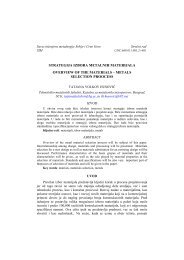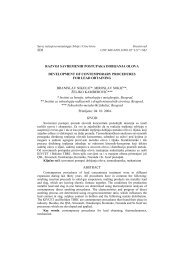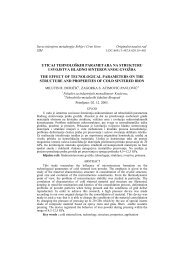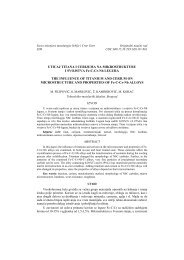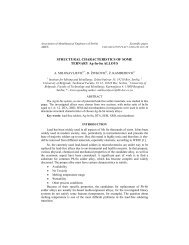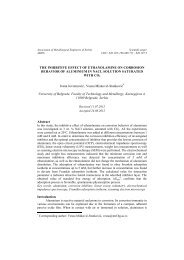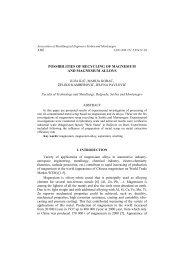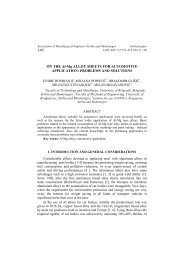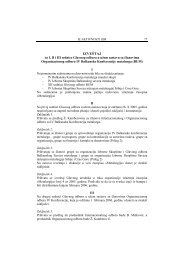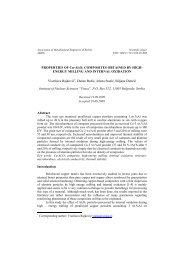a simulation system for direct chill casting of aluminium alloys
a simulation system for direct chill casting of aluminium alloys
a simulation system for direct chill casting of aluminium alloys
Create successful ePaper yourself
Turn your PDF publications into a flip-book with our unique Google optimized e-Paper software.
Association <strong>of</strong> Metallurgical Engineers Serbia and Montenegro Invited paper<br />
AME<br />
UDC:669.715.001.572-146=20<br />
A SIMULATION SYSTEM FOR DIRECT CHILL<br />
CASTING OF ALUMINIUM ALLOYS<br />
BOŽIDAR ŠARLER 1 , MIHA ZALOŽNIK 1 , ROBERT VERTNIK 1 ,<br />
JANEZ PERKO 1 , RAJKO ŠAFHALTER 2 , MARINA JELEN 2 ,<br />
VILJEM STRNAD 2 , FRANCI TOMAZINI 2<br />
1 Laboratory <strong>for</strong> Multiphase Processes, Nova Gorica Polytechnic, Slovenia,<br />
2 IMPOL d.d., Research department, Slovenska Bistrica, Slovenia<br />
ABSTRACT<br />
This paper represents an overview <strong>of</strong> a <strong>simulation</strong> <strong>system</strong> <strong>for</strong> <strong>direct</strong>-<strong>chill</strong> <strong>casting</strong> <strong>of</strong><br />
<strong>aluminium</strong> <strong>alloys</strong>. The <strong>simulation</strong> <strong>system</strong> calculates transient fluid and solid mechanics<br />
phenomena in the slabs and billets as a function <strong>of</strong> the process parameters. Basic<br />
characteristics <strong>of</strong> the <strong>system</strong> are shown. The <strong>system</strong> is currently used <strong>for</strong> optimum<br />
setting <strong>of</strong> the process parameters and calculation <strong>of</strong> the caster regulation parameters.<br />
Verification and validation process <strong>of</strong> the <strong>system</strong> are briefly described. Representative<br />
examples <strong>of</strong> the <strong>system</strong> output are shown.<br />
Keywords: numerical model, temperature, velocity, microsegregation, macrosegregation,<br />
optimisation<br />
1. INTRODUCTION<br />
The Slovenes produce about seven times more primary <strong>aluminium</strong> than the<br />
EU average and about three times more <strong>aluminium</strong> products than the EU<br />
average. Consequently, there is a great interest in advanced process and<br />
materials development connected with <strong>aluminium</strong>.<br />
Direct <strong>chill</strong> (DC) <strong>casting</strong> [1] is currently the most common semi-continuous<br />
<strong>casting</strong> practice in non-ferrous metallurgy. In this process molten metal is fed<br />
through a bottomless water-cooled mould, where a solid shell <strong>for</strong>ms around the<br />
outer surface, which is sufficiently thick that the <strong>casting</strong> takes the shape <strong>of</strong> the<br />
mould and acquires the sufficient mechanical strength to support the molten<br />
core in the centre. As the strand emerges from the mould, water flows from the<br />
mould and impinges <strong>direct</strong>ly on the ingot surface (<strong>direct</strong> <strong>chill</strong>), falls over the<br />
cast surface and completes the solidification. Many improvements <strong>of</strong> the<br />
process have been made in last years, such as the pressurized air gap between<br />
the mould and the ingot, more advanced multi-zone DC cooling, etc. In parallel<br />
with the constructional changes, many improvements have been made with use<br />
<strong>of</strong> the in<strong>for</strong>matisation technology in DC <strong>casting</strong>.
226<br />
MJoM<br />
METALURGIJA - JOURNAL OF METALLURGY<br />
The principal aim <strong>of</strong> any materials science modelling [2-5] is in the first<br />
place the prediction the product properties as a function <strong>of</strong> the process<br />
parameters. This task can be broken down into following three linked subtasks:<br />
modelling <strong>of</strong> the relations between process parameters and macrostructure <strong>of</strong><br />
the product, modelling the relations between macrostructure and microstructure<br />
<strong>of</strong> the product, and finally, modelling <strong>of</strong> the relations between microstructure<br />
and properties <strong>of</strong> the product. Despite the massive developments <strong>of</strong> related<br />
theory, experiments and computation, the task <strong>of</strong> predicting the properties <strong>of</strong> the<br />
product as a function <strong>of</strong> the process parameters through modelling alone is still<br />
a largely unresolved problem. However, some shortcuts leading to reasonable<br />
results are possible if modelling is complemented by empirical findings.<br />
In order to improve the <strong>direct</strong>-<strong>chill</strong> <strong>casting</strong> process, the following strategy<br />
has been adopted at IMPOL d.d. company: (1) improved insight into the<br />
process, (2) improved control <strong>of</strong> the process, (3) improved understanding <strong>of</strong> the<br />
process, and (4) improved organisation <strong>of</strong> the work, connected with the process.<br />
(1) Improved insight into the process has been achieved with computer<br />
monitoring, acquisition, and storage <strong>of</strong> the process parameters [6].<br />
(2) Improved control <strong>of</strong> the process has been achieved with the computerised on-line<br />
automatic setting <strong>of</strong> optimum process parameters.<br />
(3) Improved understanding <strong>of</strong> the process has been achieved with the computer models<br />
<strong>of</strong> different involved phenomena.<br />
(4) Improved organisation <strong>of</strong> work around the process has been achieved with the<br />
modified working and safety guidelines, and with training <strong>of</strong> the workers.<br />
2. SIMULATION SYSTEM<br />
The <strong>simulation</strong> <strong>system</strong> [7] (Fig. 1) calculates the steady and transient<br />
temperature (Fig. 2), velocity (Fig. 3), and concentration (Fig. 4) fields in DC<br />
cast billets and slabs. The <strong>system</strong> is in constant upgrading since the beginning <strong>of</strong><br />
the nineties. The transport phenomena are calculated within the mixture<br />
continuum <strong>for</strong>mulation. For this purpose a set <strong>of</strong> macroscopic equations is<br />
employed [8], which include mass conservation, species conservation <strong>for</strong> each<br />
alloying element, momentum conservation and energy conservation equations.<br />
The macroscopic <strong>system</strong> <strong>of</strong> equations is closed by a set <strong>of</strong> microscopic<br />
considerations [9] from which the phase quantities are calculated from the<br />
mixture quantities. The thermal stress and de<strong>for</strong>mation calculations rely on the<br />
assumption <strong>of</strong> the rate <strong>of</strong> de<strong>for</strong>mation change due to elastic de<strong>for</strong>mation,<br />
viscoplastic de<strong>for</strong>mation, thermal de<strong>for</strong>mation (Fig. 5) and de<strong>for</strong>mation due to<br />
phase change [10]. The <strong>system</strong> can interface with the <strong>aluminium</strong> <strong>alloys</strong> material<br />
properties database JMatPro [11].<br />
Not all <strong>of</strong> the listed models are numerically implemented at the present<br />
time. Some <strong>of</strong> the models are employed only <strong>for</strong> steady state computations<br />
without transient capabilities, some <strong>of</strong> them are <strong>for</strong> binary <strong>alloys</strong> only.
A SIMULATION SYSTEM FOR DIRECT CHILL CASTING … 227<br />
Fig. 1. Schematics <strong>of</strong> the <strong>simulation</strong> <strong>system</strong><br />
3. VERIFICATION AND VALIDATION<br />
OF THE SIMULATION SYSTEM<br />
Parallel to the development <strong>of</strong> the DC <strong>casting</strong> models, experimental<br />
techniques related to the DC <strong>casting</strong> process were developed. They were<br />
designed and measurements carried out in the IMPOL d.d. company.<br />
The verification <strong>of</strong> the <strong>system</strong> represents the answer to the question: Are<br />
we solving the equations correctly For this purpose the governing equations<br />
are solved with the classical numerical method, as it is used in the <strong>simulation</strong><br />
<strong>system</strong>, and with some alternative numerical method, such as <strong>for</strong> example the<br />
dual reciprocity boundary element method [12] or diffuse approximation<br />
method (Fig. 6).<br />
The validation <strong>of</strong> the <strong>system</strong>s represents the answer to the question: Are the<br />
equations we are solving correct For this purpose the model results were<br />
compared with the results <strong>of</strong> experiments [13]. The simplest measurement is the<br />
product de<strong>for</strong>mation. The measurements <strong>of</strong> the depth <strong>of</strong> the liquid sump in case<br />
<strong>of</strong> pure aluminum can be carried out by insertion <strong>of</strong> a steel rod into the sump.<br />
The position <strong>of</strong> the mushy zone can be measured by flooding <strong>of</strong> the liquid sump<br />
by zinc (Fig. 7) that is much heavier than <strong>aluminium</strong> and floats out the molten<br />
<strong>aluminium</strong>. The measurements <strong>of</strong> the steady and transient temperature fields in<br />
the DC cast strands can be per<strong>for</strong>med (Fig. 8) by immersion <strong>of</strong> thermocouples<br />
[14].<br />
Because <strong>of</strong> safety considerations this cannot be done in the vicinity <strong>of</strong> the<br />
strand surface. Because <strong>of</strong> that, heat flux measurements have been per<strong>for</strong>med on<br />
the DC billet surface with a specially designed measurement device (Fig. 9) <strong>for</strong><br />
measuring the cooling water temperature increase [15]. This data is used <strong>for</strong><br />
calculation <strong>of</strong> the heat flux boundary conditions. The concentrations <strong>of</strong> alloying<br />
elements (macrosegregation) in the cast product are measured by the emission<br />
spectroscopy.
228<br />
MJoM<br />
METALURGIJA - JOURNAL OF METALLURGY<br />
0<br />
-0.02<br />
-0.04<br />
-0.06<br />
y[m]<br />
-0.08<br />
-0.1<br />
T[K]<br />
870.0<br />
830.0<br />
790.0<br />
750.0<br />
710.0<br />
670.0<br />
630.0<br />
590.0<br />
550.0<br />
510.0<br />
470.0<br />
430.0<br />
390.0<br />
350.0<br />
-0.12<br />
-0.14<br />
-0.16<br />
0 0.05 0.1<br />
r[m]<br />
Fig. 2. Calculated temperature field.<br />
y[m]<br />
0<br />
-0.02<br />
-0.04<br />
-0.06<br />
-0.08<br />
-0.1<br />
f l<br />
11 0.9990<br />
10 0.9000<br />
9 0.8000<br />
8 0.7000<br />
7 0.6000<br />
6 0.5000<br />
5 0.4000<br />
4 0.3000<br />
3 0.2000<br />
2 0.1000<br />
1 0.0010<br />
-0.12<br />
-0.14<br />
y[m]<br />
-0.16<br />
0 0.05 0.1<br />
r[m]<br />
0<br />
-0.02<br />
-0.04<br />
-0.06<br />
-0.08<br />
-0.1<br />
Fig. 3. Calculated velocity field.<br />
C<br />
0.0495<br />
0.0490<br />
0.0485<br />
0.0480<br />
0.0475<br />
0.0470<br />
0.0465<br />
0.0460<br />
0.0455<br />
0.0450<br />
0.0445<br />
0.0440<br />
0.0435<br />
0.0430<br />
0.0425<br />
-0.12<br />
-0.14<br />
-0.16<br />
0 0.05 0.1<br />
r[m]<br />
Fig. 4. Calculated macrosegregation field.
A SIMULATION SYSTEM FOR DIRECT CHILL CASTING … 229<br />
Fig. 5. Calculated thermal de<strong>for</strong>mation field<br />
Fig. 6. Model verification. A comparison between FVM<br />
and Diffuse approximaion method.
230<br />
MJoM<br />
METALURGIJA - JOURNAL OF METALLURGY<br />
Fig. 7. Zinc flooding measurements.<br />
600<br />
500<br />
calculated<br />
T [°C]<br />
400<br />
300<br />
200<br />
measured<br />
solidus<br />
liquidus<br />
100<br />
0<br />
-100 0 100 200 300 400 500 600 700 800 900 1000<br />
Fig. 8. Model validation. A comparison between measured<br />
and calculated billet temperatures.<br />
Fig. 9. Thermocouple rack <strong>for</strong> heat flux measurements
A SIMULATION SYSTEM FOR DIRECT CHILL CASTING … 231<br />
4. USE OF THE SIMULATION SYSTEM<br />
A very recent experimental version <strong>of</strong> the <strong>system</strong> is used in the Laboratory<br />
<strong>for</strong> multiphase processes only. The further developed version with user-friendly<br />
interfaces and user help (Fig.10) are employed by the Research department and<br />
technologists <strong>of</strong> the IMPOL company. The <strong>system</strong> is used in the <strong>of</strong>f-line and in<br />
the on-line mode. The on-line mode is used primarily <strong>for</strong> calculation <strong>of</strong> the<br />
process regulation coefficients. The <strong>of</strong>f-line mode is used in estimation <strong>of</strong> the<br />
proper <strong>casting</strong> conditions and optimization <strong>of</strong> the <strong>casting</strong> conditions with<br />
respect to the heat fluxes, water temperature increase, position <strong>of</strong> the melt in the<br />
mould/graphite ring, position <strong>of</strong> the solidus and liquidus at the surface and at the<br />
centre <strong>of</strong> the strand. Current developments are primarily <strong>direct</strong>ed into<br />
optimization <strong>of</strong> the product macrosegregation pattern and microstructure.<br />
Fig. 10. A typical input-output dialog box.<br />
5. CONCLUSIONS<br />
Computer modelling techniques are now widely used in all scientific<br />
disciplines. A particularly fruitful area <strong>of</strong> application is the field <strong>of</strong> materials<br />
science, where the computational tools are now indispensable <strong>for</strong> studying and<br />
optimisation <strong>of</strong> the structure, properties and processing <strong>of</strong> materials. This paper<br />
gives an overview <strong>of</strong> the computational methodologies used in connection with<br />
the DC <strong>casting</strong> process in IMPOL d.d. company in the last decade. The <strong>system</strong><br />
is successfully used <strong>for</strong> improvement <strong>of</strong> the process yield and product quality.<br />
Acknowledgment: The authors wish to express their gratitude to IMPOL<br />
<strong>aluminium</strong> industry, Slovenska Bistrica, Slovenia and the Slovenian Ministry <strong>of</strong><br />
Education, Science and Sport (projects J2-6403-1540-04, L2-5387-1540-03) <strong>for</strong><br />
support <strong>of</strong> this work.
232<br />
MJoM<br />
METALURGIJA - JOURNAL OF METALLURGY<br />
REFERENCES<br />
[1] L. Katgerman, S.C. Flood, A.H. Langille, Production, Refining, Fabrication and<br />
Recycling <strong>of</strong> Light Metals, (eds. M.Bouchard et al.), Pergamon, New York, 1990,<br />
pp.96-110.<br />
[2] V.R. Voller, H. Henein, Materials Processing in the Computer Age III, TMS,<br />
Warrendale, 2000.<br />
[3] D.M. Stefanescu, J.A. Warren, M.R. Jolly, M.J.M. Krane (eds.), Modelling <strong>of</strong><br />
Casting, Welding and Advanced Solidification Processes X, Shaker, Aachen, 2003.<br />
[4] B. Šarler, C.A. Brebbia (eds.), Computational Modelling <strong>of</strong> Moving and Free<br />
Boundary Problems, WIT Press, Southampton, 2001.<br />
[5] B. Šarler, D. Gobin (eds.), EUROTHERM 69: Heat and Mass Transfer in Solid-<br />
Liquid Phase Change Processes, Založba Politehnike Nova Gorica, Nova Gorica,<br />
2003.<br />
[6] M. Sabolič-Mijovič, B. Šarler, Computer <strong>system</strong> <strong>for</strong> data acquisition and<br />
monitoring <strong>of</strong> the DC <strong>casting</strong> process, Valve, Vol. 5, 1999, pp.41-45.<br />
[7] B. Šarler, M. Založnik. R. Vertnik, J. Perko, R. Šafhalter, M. Jelen, V. Strnad,<br />
F. Tomazini, A <strong>simulation</strong> <strong>system</strong> <strong>for</strong> continuous <strong>casting</strong> <strong>of</strong> <strong>aluminium</strong> <strong>alloys</strong>,<br />
Version 12-2003, LMP, Nova Gorica Polytechnic, 2003.<br />
[8] J. Ni, F.P. Incropera, Extension <strong>of</strong> the continuum model <strong>for</strong> transport phenomena<br />
occurring during metal alloy solidification – I. The conservation equations, Int. J.<br />
Heat Mass Transfer, Vol. 38, 1995, pp.1271-1284.<br />
[9] J. Ni, F.P. Incropera, Extension <strong>of</strong> the continuum model <strong>for</strong> transport phenomena<br />
occurring during metal alloy solidification - II. Microscopic considerations, Int. J.<br />
Heat Mass Transfer, Vol. 38, 1995, pp.1285-1296.<br />
[10] J. Mencinger, B. Šarler, The development <strong>of</strong> methodology <strong>for</strong> estimation <strong>of</strong> the<br />
mould tapper in DC <strong>casting</strong> <strong>of</strong> <strong>aluminium</strong> <strong>alloys</strong>, Part 1, Ingot shape due to thermal<br />
de<strong>for</strong>mations, LFDT, Faculty <strong>of</strong> mechanical engineering, University <strong>of</strong> Ljubljana,<br />
Ljubljana, 2001.<br />
[11] N. Saunders, X. Li, P. Miodownik, J.-P. S<strong>chill</strong>e: J.-C. Shao et al. (eds.), Proc.<br />
Symp. Materials Design Approaches and Experiences, TMS, Warrendale, 2001,<br />
pp.185-197.<br />
[12] B. Šarler, J. Mencinger, Solution <strong>of</strong> temperature field in DC cast <strong>aluminium</strong> alloy<br />
billet by the dual reciprocity boundary element method, Int. J. Numer. Methods<br />
Heat & Fluid Flow, Vol. 9, 1999, pp. 269-295.<br />
[13] B. Šarler, M. Jelen, R. Šafhalter, F. Tomazini, D. Panzalović, Comparison <strong>of</strong><br />
measured and calculated solid-liquid interphase position during DC <strong>casting</strong> <strong>of</strong><br />
<strong>aluminium</strong>, P. Agnostopoulos et al. (eds.), Computational Methods and<br />
Experimental Measurements VIII, CMP, Southampton, 1997, pp.599-609.<br />
[14] B. Šarler, M. Jelen, R. Šafhalter, F. Tomazini, Comparison <strong>of</strong> measured and<br />
calculated temperature field in <strong>aluminium</strong>-copper alloy DC <strong>casting</strong>, A.J. Nowak et<br />
al (eds.), Heat Transfer V, CMP, Southampton, 1998, pp.253-266.<br />
[15] M. Založnik, B. Šarler, I. Bajsić, A non-destructive experimental approach <strong>for</strong> heat<br />
flux determination on <strong>direct</strong>-<strong>chill</strong> cast <strong>aluminium</strong> alloy billet surface, Proceedings<br />
in applied mathematics and mechanics, Vol. 2, 2003, pp.300-301.




